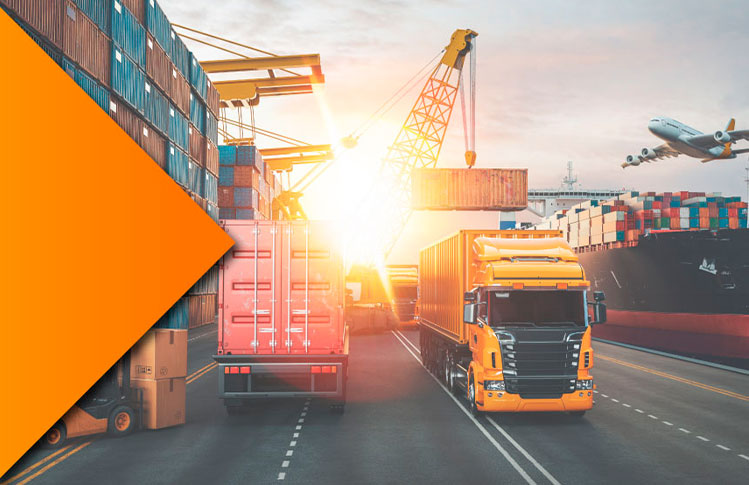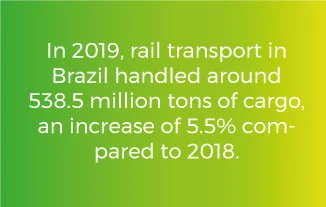
Market size, sustainability, automation and its challenges!
We invite you to take a journey on rails, ships, planes and explore the logistics market, its pains and how adequate LED lighting can benefit this chain.
Look what you will find in this article:
The global logistics market moved around USD 10.6 trillion in 2020 and is expected to grow at a compound annual growth rate of 7.6% between 2021 and 2028.
And sustainability is becoming a growing concern in the sector, with companies seeking to reduce their carbon footprint in their operations, adopt more sustainable transportation and packaging practices and, above all, increase the energy efficiency of their facilities.
One of the most popular solutions for this is automation. It is becoming increasingly important in the logistics sector, with the increasing use of robots, autonomous vehicles and drones to transport goods and perform tasks such as picking and packing orders, and obviously extends to lighting.
In 2020, the pandemic further accentuated global supply chain challenges, with disruptions to the supply of spare parts and products, increased transportation costs, and the need to adopt health safety measures to ensure continuity of operations.
In logistics, modalities refer to the different types of transportation used to move goods or people from one place to another. There are several modes of transportation available, each with its own characteristics and advantages. Choosing the most appropriate modality depends on several factors, such as distance, delivery time, type of cargo, costs, availability and efficiency. The careful selection of the type of transportation can be one of the most important decisions in the supply chain, since it can directly affect the cost, time and quality of the logistics service offered.
The most popular modes of transport are:
Road: Road transport is carried out by trucks, buses and other land vehicles.
Rail: land transportation carried out by trains, which are ideal for transporting large volumes of cargo and long distances.
Waterway: water transport carried out by ships, boats and rafts.
Air: Transportation is carried out by plane, which is fast and efficient, but generally more expensive than other modes and with lower carrying capacity.
Pipeline: Transportation via pipelines, which are primarily used for the transportation of liquids and gases, such as oil and natural gas.
According to the United Nations Conference on Trade and Development (UNCTAD), maritime transport represents around 80% of global trade by volume, handling more than 11 billion tonnes of goods annually. The main types of cargo transported by sea include oil, containers, iron ore, coal and grain.

Maritime transportation is a vital part of Brazil’s economy, due to its extensive coastline and the presence of important ports throughout the country. Below are some relevant data about the sector in Brazil:
With a coastline of about 7,500 km, with more than 40 seaports. Currently, there are 219 Private Use Terminals (TUP) and 42 Organized Ports in operation in Brazil.
The main ports of the country are Santos (SP), Paranaguá (PR), Rio Grande (RS), Itajaí (SC), Suape (PE), Itaqui (MA) and Fortaleza (CE).
Ports are responsible for around 95% of Brazilian foreign trade, and the majority of the country’s exports are commodities such as soybeans, iron ore and oil.
In 2020, the total volume of cargo handled by Brazilian ports was around 1.15 billion tons, an increase of 4.2% compared to 2019.
The main type of ship used to transport cargo in Brazil is the bulk carrier, which is capable of transporting large quantities of bulk commodities such as iron ore, soybeans and corn.
Brazil also has a significant shipbuilding industry, with companies manufacturing ships for use in the domestic market and for export.
With plans to modernize and expand ports, the aim is to increase efficiency and reduce the costs of maritime transportation in the country.
If agro is pop, and who will say the logistics?
According to the Confederation of Agriculture and Livestock of Brazil (CNA), the transport of agricultural cargo represents about 60% of the total cargo transported in Brazil.
Brazil is one of the world’s leading producers of agricultural raw materials, such as soybeans, corn, sugar and coffee. The transportation of these products is essential for the Brazilian economy and for global food security.
Logistics in the agricultural sector is challenging due to the need to transport perishable and temperature-sensitive products, as well as dealing with weather conditions and limited infrastructure in some regions.
Logistics warehouses and agribusiness
According to the Brazilian Logistics Association (Abralog), it is estimated that there are around 12,500 warehouses in the country, of which around 20% are located in São Paulo.
The Ministry of Agriculture, Livestock and Supply (MAPA) estimates that there are around 300 grain warehouses in the country, with a storage capacity of more than 1 million tons of grain. These warehouses are mainly used for the storage of soybeans, corn and other grains.
This highlights the importance of these segments in our economy and how important they are in terms of energy consumption and reduction of polluting gas emissions.

Railway logistics in Brazil
The Brazilian railway system is nearly 29,000 kilometers long. In Brazil, rail transport is responsible for about 15% of freight transport in the country.
The main cargoes transported by rail in Brazil are iron ore, soybeans, sugar, corn, steel products and, especially, heavy and bulky cargoes. These are better transported by rail than other modes.
There are modernization and expansion programs for the railway system, with the aim of increasing cargo transportation capacity and reducing the country’s logistics costs.
The main challenge facing rail logistics in Brazil is the lack of adequate investments and maintenance, resulting in obsolete infrastructure with low transportation capacity and high operating costs.
Railway terminals are facilities that allow the transfer of cargo between different trains, or between trains and other modes of transport, such as trucks or ships.
In Brazil, railway terminals are responsible for connecting the country’s main producing regions with ports and other destinations, allowing the flow of production and the transportation of goods.
The country has more than 140 railway terminals in operation, with emphasis on the South, Southeast and Central West regions.
Brazilian rail terminals primarily move solid bulk cargoes, such as iron ore, grains and fertilizers.
The main railway terminals in Brazil are located in strategic areas, close to large urban centers and ports, such as the Port of Santos and the Port of Paranaguá.
The infrastructure of railway terminals in Brazil varies depending on the size and capacity of each facility, but they generally have switching yards, loading and unloading platforms, and storage systems.
Some examples of railway terminals in Brazil are the Fernão Dias Cargo Terminal, in São Paulo, the Paranaguá Cargo Terminal, in Paraná, and the Uberaba Cargo Terminal, in Minas Gerais.
Multimodal terminals are logistics facilities that enable the efficient transfer of cargo between different modes of transportation, such as rail, road, waterway and air. These terminals are designed to optimize the supply chain, reduce logistics costs and improve operational efficiency.
Multimodal terminals are usually located in strategic areas, such as near ports and airports, and have the appropriate infrastructure for the transfer of cargo between different modes of transportation. They offer cargo storage, handling and distribution services, as well as container consolidation and deconsolidation services.
The main advantage is that they allow the integration of different modes of transportation in a single logistics operation, which can result in cost reduction and greater efficiency. For example, cargo arriving by ship can be transferred to a multimodal terminal and then transported by train or truck to the final destination, rather than using a single mode of transportation.
Brazil has more than 100 multimodal terminals in operation in different regions of the country, with emphasis on the South and Southeast regions.
Brazilian multimodal terminals mainly handle container cargo, dry bulk, liquid bulk and general cargo.
The main multimodal terminals in Brazil are located near ports, airports and large urban centers, highlighting the Port of Santos, the largest port in the country, which has a large number of multimodal terminals in its region.
The use of LED in the logistics sector
The use of LED lighting in the logistics sector has proven to be an effective solution to improve energy efficiency and reduce operating costs. LED technology offers several advantages over traditional light bulbs, including greater durability, lower energy consumption and easier maintenance.
Widely used in warehouses, warehouses and distribution centers providing better light quality compared to traditional lamps, making it easier for workers to search and manipulate products in low-light environments.
They consume around 60% less energy compared to traditional fluorescent lamps, which translates into significant savings on electricity costs. Plus, LED lights have a longer lifespan than traditional light bulbs, meaning less maintenance and replacement costs. In addition to helping reduce the risk of accidents and improving workers’ visibility.
In summary, LED lighting is an effective solution for the logistics sector, as it provides greater energy efficiency, improves the quality of light and increases safety in the work environment. With growing awareness of the importance of energy efficiency and sustainability, more companies in the logistics sector are expected to adopt LED lighting as a viable solution to improve operational efficiency and reduce costs.
CNPJ 54.601.612/0001-69
Conex Eletromecânica Ind e Com Ltda.
A Conexled procura constantemente novos fornecedores para seus negócios.
Se você tem interesse em ser um de nossos parceiros, preencha o formulário abaixo.
Quer ser um representante da Conexled?
Se você tem interesse em ser um parceiro da marca, preencha o formulário abaixo.
Ficou com alguma dúvida, ou precisa de ajuda para escolher a melhor solução para seu projeto?
Fale diretamente com um de nossos consultores.